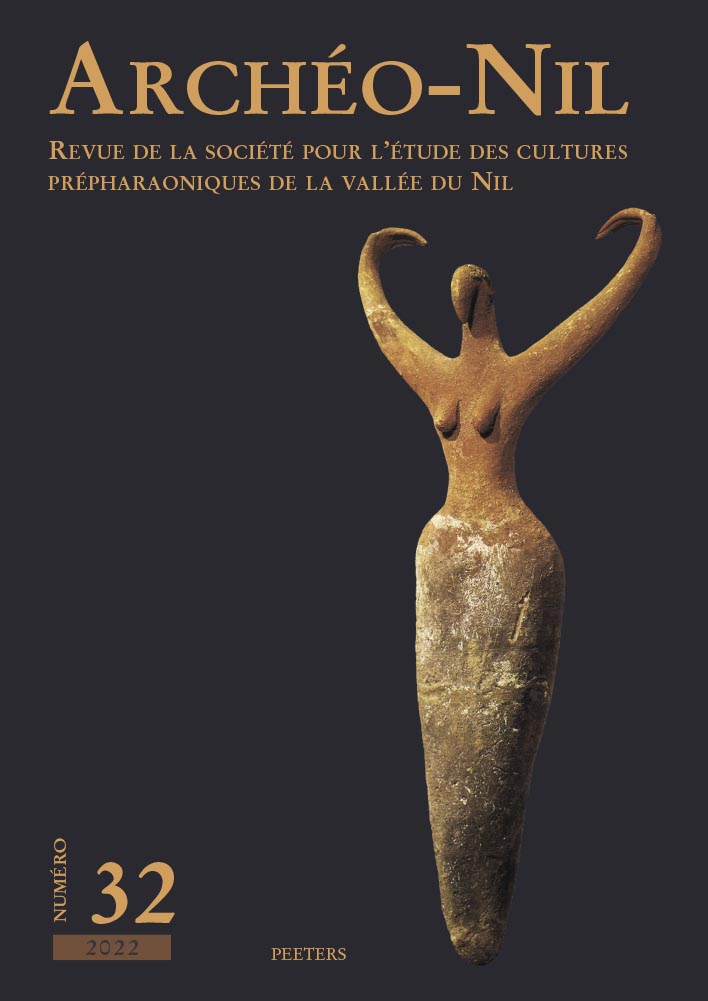 previous article in this issue previous article in this issue | next article in this issue  |

Preview first page |
Document Details : Title: Fayumian Pottery Tradition Subtitle: A Preliminary Study on the Assemblage from Trench 1 at Site E29H2 (Kom W), Fayum Author(s): MĄCZYŃSKA, Agnieszka Journal: Archéo-Nil Volume: 32 Date: 2022 Pages: 73-103 DOI: 10.2143/ANI.32.0.3291132 Abstract : The sites identified in the Fayum in the 1920s, containing remains left by the communities operating on the shore of Lake Qarun in the early and middle Holocene have attracted researchers interested in Egyptian Prehistory since their discovery. Over the next 100 years, multiple expeditions have returned to the Fayum in search for new evidence. In the 1968/1969 season, the Combined Prehistoric Expedition (CPE) surveyed the area between Qasr el-Sagha and Kom Aushim on the northern rim of the Fayum Depression. The research also covered the area of Kom W, referred to as E29H2. Two new trenches were open just outside the southwest corner of the area excavated by Caton-Thompson and Gardner. Fragments of charcoal, ceramics, lithics, and animal bones were recorded in both. The main objective of the paper is to define the chaîne opératoire for the Fayumian pottery tradition on the basis of the analysis of the ceramic assemblage from Trench 1 at site E29H2. When applied to pottery analysis, the techno logical approach makes it possible to determine the variability of a ceramic assemblage and to interpret it on the synchronic and diachronic axes. By comparing the reconstructed manufacturing chaîne opératoire to the local Lower Egyptian production sequence proposed for the 4th millennium BCE by J. Bajeot and V. Roux, the dynamic of the pottery tradition between the Neolithic and Chalcolithic periods can be analysed. As the Fayumian and Lower Egyptian cultures used the same roughing out technique (the fabric and the coiling by pinching technique) which is part of the technical tradition that was stable and resistant to change through time and space, it is evident that they belong to the same pottery tradition which developed continuously from the 2nd part of the 6th millennium to the 4th millennium BCE. Les sites identifiés dans le Fayoum dans les années 1920, avec des vestiges laissés par les communautés opérant sur les rives du lac Qarun au début et au milieu de l’Holocène, ont attiré depuis leur découverte les chercheurs intéressés par la préhistoire égyptienne. Au cours des cent années suivantes, plusieurs expéditions sont retournées dans le Fayoum à la recherche de nouveaux documents. Au cours de la saison 1968/1969, la Combined Prehistoric Expedition (CPE) a étudié la zone située entre Qasr el-Sagha et Kom Aushim sur le bord nord de la dépression du Fayoum. Les recherches couvraient également la zone de Kom W, désignée sous le nom de E29H2. Deux nouvelles tranchées ont été ouvertes juste à l’extérieur de l’angle sud-ouest de la zone fouillée par Caton-Thompson et Gardner. Dans les deux, des fragments de charbon de bois, du matériel céramique et lithique ainsi que des os d’animaux ont été enregistrés. L’objectif principal de cet article est de définir la chaîne opératoire de la tradition potière du Fayoum sur la base de l’analyse de l’assemblage céramique de la tranchée 1 du site E29H2. Appliquée à l’analyse de la poterie, l’approche technologique permet de déterminer la variabilité d’un assemblage céramique et de l’interpréter sur les axes synchroniques et diachroniques. En comparant la chaîne opératoire de fabrication reconstituée à la séquence de production locale de Basse Égypte proposée pour le 4e millénaire BCE par J. Bajeot et V. Roux, on peut analyser la dynamique de la tradition potière entre le Néolithique et le Chalcolithique. Comme les cultures du Fayoum et de Basse Égypte utilisaient la même technique de préparation (la technique du tissu et celle de l’enroulement par pincement), qui fait partie de la tradition technique, stable et persistante aux changements à travers le temps et l’espace, elles appartiennent à la même tradition potière, qui s’est développée de manière continue de la deuxième partie du 6e millénaire au 4e millénaire BCE. |
|


